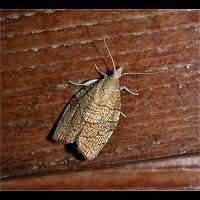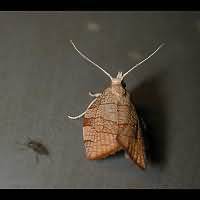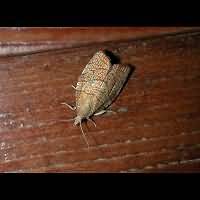Chequered Fruit-tree Tortrix (Pandemis corylana)
The Chequered Fruit-tree Tortrix, also known as the Hazel Tortrix Moth or Filbert Tortricid is part of a group of look-a-like Tortrixes. Most of these are bad news in agriculture. They are all brownish with a pattern of lines or bands. In this species these lines are very fine engravements, more delicate than in similar species. Usually the moth is ochreous brown with dark brown markings. The hind wing is of the same colour, but without the markings. The legs, snout and antennae are whittish and unmarked. Normally females are darker than males and their markings are more intense. Variations within this species do occur. The colour in some cases is a dark, almost reddish, brown. In other cases greyish animals occur. However in the field this generally is not a very difficult species to identify, except for a pale brown, unmarked variety, which is very hard to identify at times. Size wise this is a typical Tortrix Moth, reaching a wingspan of some 18 to 21 mm in Britain and up to 24 mm on the continent.
The caterpillars are dark emerald green all over, except for a very few yellow markings found on the head. They are rather slender and reach a length of some 25 mm. Like other tortrixes they live between two leaves spun together, or within one folded leaf. The larvae hatch in autumn and overwinter. In May they become active again and eat fresh foliage. From June onwards they pupate in leaves of the same host plant they have been feeding on. The pupa is brown and some 15 mm long. The new adult moths appear from July to September. The caterpillars are polyphagous, which means they feed on the leaves many trees and shrubs. In Britain among many others Oak, Beech, Birch and Cherries are mentioned. However they have also been found in Ivy and Honeysuckle. Sometimes they appear in great numbers on cultivated apples and hazel, capable of causing considerable damage.
The pheromone of this species is virtually unknown. There are no natural enemies that could be useful to farmers, as only one parasitic fly is known to lay its eggs in the larvae or pupae, but this is not a specialized species. By day the moth can be found on leaves in shrubs. When disturbed it will fly away, but usually it only flies by night. Males especially are attracted by light, females less so. A common species over most of Britain. Also found in Northern and Central Europe, Northern Asia, Korea and Japan. Has been caught in New Zealand as well, but probably not a plague over there.
The Chequered Fruit-tree Tortrix, also known as the Hazel Tortrix Moth or Filbert Tortricid is part of a group of look-a-like Tortrixes. Most of these are bad news in agriculture. They are all brownish with a pattern of lines or bands. In this species these lines are very fine engravements, more delicate than in similar species. Usually the moth is ochreous brown with dark brown markings. The hind wing is of the same colour, but without the markings. The legs, snout and antennae are whittish and unmarked. Normally females are darker than males and their markings are more intense. Variations within this species do occur. The colour in some cases is a dark, almost reddish, brown. In other cases greyish animals occur. However in the field this generally is not a very difficult species to identify, except for a pale brown, unmarked variety, which is very hard to identify at times. Size wise this is a typical Tortrix Moth, reaching a wingspan of some 18 to 21 mm in Britain and up to 24 mm on the continent.
The caterpillars are dark emerald green all over, except for a very few yellow markings found on the head. They are rather slender and reach a length of some 25 mm. Like other tortrixes they live between two leaves spun together, or within one folded leaf. The larvae hatch in autumn and overwinter. In May they become active again and eat fresh foliage. From June onwards they pupate in leaves of the same host plant they have been feeding on. The pupa is brown and some 15 mm long. The new adult moths appear from July to September. The caterpillars are polyphagous, which means they feed on the leaves many trees and shrubs. In Britain among many others Oak, Beech, Birch and Cherries are mentioned. However they have also been found in Ivy and Honeysuckle. Sometimes they appear in great numbers on cultivated apples and hazel, capable of causing considerable damage.
The pheromone of this species is virtually unknown. There are no natural enemies that could be useful to farmers, as only one parasitic fly is known to lay its eggs in the larvae or pupae, but this is not a specialized species. By day the moth can be found on leaves in shrubs. When disturbed it will fly away, but usually it only flies by night. Males especially are attracted by light, females less so. A common species over most of Britain. Also found in Northern and Central Europe, Northern Asia, Korea and Japan. Has been caught in New Zealand as well, but probably not a plague over there.






